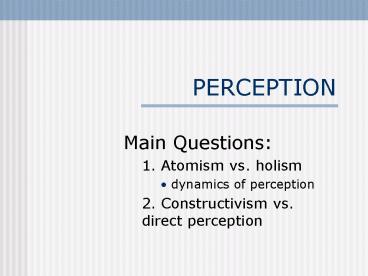PERCEPTION - PowerPoint PPT Presentation
1 / 24
Title:
PERCEPTION
Description:
A percept arises from the interaction of stimuli and knowledge (expectations) -- ALWAYS ... Damage to inferior temporal lobe, patient DF: visual form agnosia: ... – PowerPoint PPT presentation
Number of Views:1054
Avg rating:3.0/5.0
Title: PERCEPTION
1
PERCEPTION
- Main Questions
- 1. Atomism vs. holism
- dynamics of perception
- 2. Constructivism vs. direct perception
2
Constructivism
Top-down processing
- Stimulation from environment scarce and
ambiguous. Perception relies on knowledge. - A percept arises from the interaction of stimuli
and knowledge (expectations) -- ALWAYS - Main theorists and researchers Boring, Bruner,
Neisser (70), Rock
3
(No Transcript)
4
(No Transcript)
5
Constructivism explains
- The influence of experience on perception
- Familiarity ? perception (e.g., Bruner i Postman,
1949) - Using context in situations of impoverished
stimulation - Illusions
6
(No Transcript)
7
(No Transcript)
8
Critique of constructivism
- Everyday perception is rather accurate
- The problem of the origin of knowledge and
expectations - Critique of research conducted in situations of
insufficient stimulation (short presentations,
limited visibility, passive observer)
9
Direct perception
- James Gibson (1966, 1979), Eleanor Gibson
- Other names gibsonism, ecological psychology,
bottom-up processing - Ask not whats in your head but what your head
is inside of.
10
- HOW? -gt WHAT?
- Goal to account for everyday functioning in the
environment - Information is rich enough to directly specify
possible reactions - Processing and knowledge influence are
unnecessary - Information about affordances (perception and
action are inseparable) - Information is contained in optic array,
received by an active, moving observer
structured light. - Tuning to the world effect of organisms
evolution in a specific environment (tuning not
learning).
11
Advantages
- Accounts for accuracy of perception
- Emphasis on
- What is really picked up from the environment
- The importance of innate constraints of
perception - Dynamic character of perception (movement,
activity of observer) - The importance of studying perception in natural
conditions (ecological validity of research)
12
Disadvantages
- - Difficult to explain
- Perception errors
- Perception in situations of limited stimulation
(context and knowledge influences) - Re-cognition and multi-cognition the
possibility of taking multiple views on an object - - Affordances of artifacts?
13
Synthesis Neisser 1976
- Perceptual cycle relative importance of ??
depends on a situation
Information from environment
modifies
samples
guides
Knowledge
Exploration
14
The debate is still alive
- Constructivists Irvin Rock Indirect Perception
1997 - Perception is intelligent
- Perception is based on prior perception.
- Eleanor Gibson, ecological psychology (Michael
Turvey, Claudia Carello)
15
Theory of TWO visual systems (Norman, 2001)
- Earlier theories
- Schneiders system where? system what?
(indication vs identification) - Cortical visual system ablation no pattern
discrimination - Undercutting the tectum disrupted orientation in
space - Systems ambient (subcortical) focal (cortical)
- Neisser 1994 separate systems direct perception
and recognition/representation - Norman gibsonian dorsal system and
constructivist ventral system
16
Evidence
- Neurophysiological
- Neuropsychological (brain damage)
- dissociations double dissociations
- Psychological experiments
17
Neurophysiological Evidence
- Ungerleider Mishkin 2 separate pathways in
visual cortex. From the occipital lobe - dorsal stream to the posterior parietal cortex,
- ventral stream to the inferior temporal cortex,
- Similar to Schneiders what and where but
both cortical - Signals from visual cortex
- dorsal movement analysis an space signals
coming from peripheral areas of retina, signals
from subcortical structures - ventral analysis of shape and color from areas
representing central parts of the retina
18
- Processing of similar information (shape,
distance, color) but for different reasons - dorsal visual control of movement, egocentric
- ventral object recognition, allocentric
- Confirmation from PET research.
19
Neuropsychological evidence(Milner and
Goodale95)
- Patients with damage in their parietal lobe
- optic ataxia indication and reaching impairment
but no trouble in discrimination and
identification of visual stimuli
20
- Damage to inferior temporal lobe, patient DF
visual form agnosia - Is not able to recognize faces and objects,
- Incapable of making siple discriminations e.g.
Between a triangle and a circle, - Cannot copy pictures nor recognize what she has
drawn (from memory), - Capable of carrying out visuomotor activities
- Inserting a card into a slot
- Picking up disks of various widths (information
about size is available to her but she cannot
judge which one is bigger) - Using tools is ok, describing not
21
Psychological experiments
- Comparing judgmental responses (evaluative) to
motor responses (reaching, grasping) to the same
stimuli in healthy subjects. - Eg. Reaching for vs. Evaluating the size of a
disk in the Titchener-Ebbinghaus illusion
- Dorsal system not prone to visual illusions?
- Induced movement illusion reported induced
eye-movements followed the real movement
direction! - Judgmental estimates of distance vs. motor
responses to distance (e.g. blindfolded walking),
angle - Summary motor responses are more accurate.
Errors do not correlate with verbal evaluation
errors.
22
(No Transcript)
23
Comparison of the dorsal and ventral systems
24
Two parallel systems corresponding to the two
theories of perception
- Concepts and methods used by gibsonists
correspond to functions of the dorsal system - Concepts and methods used by constructivists
correspond to functions of the ventral system - Two systems having different functions but
synergistic, cooperating































